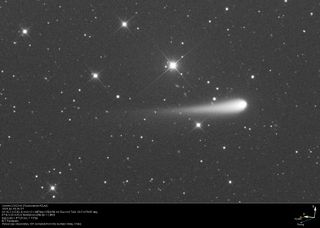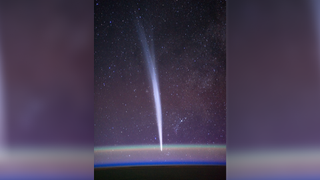Over the past few months there has been a gradual build-up of excitement about the approach of a new comet called Tsuchinshan-ATLAS, officially cataloged as C/2023 A3.
Comet Tsuchinchan-ATLAS (C/2023 A3) was first detected at the Purple Mountain Observatory’s XuYi Station in China on Jan. 9, 2023. It then disappeared and was detected a second time 44 days later by the Asteroid Earth Impact Last Warning System (ATLAS). Exploration Project in Sutherland, South Africa. It has been hopes running high That this will grow into something bright naked-eye by the fall of 2024.
but A new technical paper Recently posted on July 9th by a well-known comet expert, it states that the Tsuchinshan-ATLAS Comet instead of impressing will, in all likelihood, fall apart and disintegrate before it has a chance to orbit the Sun in late September.
The report comes from Dr. Zdinek Sekanina, a former NASA/JPL expert on comets fission and melting comets. In his report, Dr. Sekanina gives three main reasons why he believes the comet is perfect:
“The aim of this paper is not to disappoint comet-watchers who were looking forward to a new naked-eye object next October, but to present scientific arguments that are unlikely to substantiate such hopes,” writes Dr Sekanina. While publicly acknowledging that predicting the disintegration of a comet before it reaches its closest point to the sun (perihelion) is “admittedly a very dangerous undertaking”, Dr Cekinina feels that “it’s time to get on with it”.
The Tsuchinshan-ATLAS comet is expected to reach perihelion on September 27, at a distance of 36 million miles (58 million kilometers) from the sun – a distance equal to the average distance of Mercury, the nearest planet to our star.
If you want to watch Comet Tsuchinshan–ATLAS this year (if it stays the same!), our guide to the best telescope and best binoculars is a great place to start. And if you’re looking to capture astronomical images of the night sky, check out our guides on how to photograph comets, or those that recommend the best camera for astrophotography and the best lenses for astrophotography.
Who do we believe in?
Because Dr. Sekanina is highly respected in the field, whatever he says carries a lot of weight in astronomy circles. Still, his thoughts about the approaching comet’s future have been met with mixed faith and conviction with doubt and uncertainty.
One person who had high hopes for a big show at Tsuchinshan-ATLAS, but who now seems to have changed his mind based on Dr. Sekanina’s conclusion, is Joseph Marcus, a pathologist and longtime comet enthusiast. As a resident at Washington University in St. Louis, he founded and edited the quarterly “Comet News Service” published by the McDonnell Planetarium from 1975 to 1986. In an email to Space.com, Dr. Marcus writes:
“The case that Sekanina is litigating is compelling. In the unlikely event that C/2023 A3 manages to survive to the end, it would see a brightness boost of about 7 magnitudes.” (Equivalent to about 600 times increase in brightness). “But now that’s a moot point. I’ll bet on cancellation, as Sekanina is now advocating, and defer to it without precaution. After all, soon the comet will be no more,” he adds.
But others aren’t convinced … yet.
Nick James, director of the Comets section of the British Astronomical Society, says that while Secanina’s paper is “interesting”, he finds no evidence for non-gravitational acceleration. “This doesn’t look like a comet falling to pieces to me,” he says.
Another skeptic is Dr. Clay Sherrod of the Arkansas Space Observatory at Petty Jane Mountain. “That comet isn’t going anywhere; it’s just fine and not ‘party’ in my opinion,” he notes.
“Healthy” appearance
The echo of Dr. Sherrod and Mr. James, is Taras Prystavsky, an amateur astronomer who lives in Lviv, Ukraine and enjoys photographing many celestial objects such as comets. He provided Space.com with a July 9 Tsuchinshan-Atlas image, commenting: “To me the comet looks healthy. Some images reveal that the ion tail has also appeared, but it is very faint. I know the appearance of the ion tail.” It indicates that the comet’s nucleus is healthy So, there is a small hope of seeing a big show in the fall.

Finally there is Daniel Green of the Central Bureau of Electronic Telegrams (CBET), who writes cautiously: “I think the comet looks healthy, and is now showing an Ionian tail, too. I see no evidence that this comet is disintegrating.” , so now all we can do is wait and see until the end of September (if not a little sooner) if it’s a regular comet in October.”
Predicting the future is hard!
The late great baseball sage Yogi Berra once said, “It’s hard to predict, especially about the future.” These statements certainly ring true about trying to predict what a new comet might do.
While it’s true that the brightness of the Tsuchinshan-ATLAS comet was more or less flat line +10.5 degrees from mid-April to the end of June, there are signs that its brightness (based on. Comet Observation Database/COBS) has slowly begun to grow again in the first half of July.
Telescopes reveal that the comet’s dusty head, or comet’s coma, has swollen to a linear diameter of about 180,000 miles (290,000 kilometers), while its tail is now about 1 million miles (1.6 million kilometers) long. Unfortunately for northern hemisphere observers, the comet is now too close to the glare of the sun to observe; In the coming weeks, only those living south of the equator will be able to observe future developments.
The comet is currently located about 158 million miles (254 million km) from the sun and experiences temperatures of about -150°F (-100°C). It has now begun to cross the “waterline” where the freezing gases rise and evaporate. If he manages to survive to perihelion on September 27th (something Dr. Sekanina doesn’t expect to happen) then the temperature will exceed 1,000 degrees F (1,600 degrees Celsius).
Hot tea analogy
Now picture this: here we have a piece of material that seems to date back to the beginning of the solar system, about 5 billion years ago, locked in an incredibly cold environment all along with temperatures hovering near absolute zero. But in the coming weeks it will face warm temperatures of several hundred degrees.
So, what happens when you pour hot tea into a cold glass?
That may happen to the Tsuchinshan-Atlas Comet in the coming weeks; It can break and fall apart completely.
not a foregone conclusion
Does this mean that, as Dr. Sekanina titled his paper, that it is. “The Inevitable Final” For the Tsuchinshan-ATLAS Comet?
It doesn’t have to be.
In November 2011, Australian amateur astronomer Terry Lovejoy discovered a very small comet, passing just 1,600 feet (500 meters) in diameter Only 87,000 miles (140,000 km) In terms of the sun. He was not expected to survive and yet he somehow survived and in short put on a very visually beautiful performance For Southern Hemisphere observers (a short time later, after it circled the Sun, Comet Lovejoy did disintegrate as it headed back into space).

And in 1996, a comet touted as “can’t miss” was heading toward the sun and then suddenly and inexplicably stopped brightening all the way from the first week of July until mid-October. Then suddenly the comet got back on track and began to brighten, but then dimmed again at the same pace by mid-November. Some were very concerned that the comet would be a flop. But by the spring of 1997, all fears were put to rest as the comet grew into a beautiful celestial display.
The name of the comet? The line-bop.
So, maybe Yogi was right, his predictions about the future is hard. And perhaps the only thing we can do now, as Daniel Green suggests, is take a “wait and see” attitude about what Tsuchinshan-Atlas will do in the coming days and weeks. It may be dissolved, as Dr. Sekanina predicts, but at present it is still whole and faithful.
And to that end, allow me to invoke an ultimate yogi-ism:
“It’s not over, until it’s over!”
Joe Rau works as an instructor and guest lecturer in New York The Haydn Planetarium. . . . About Astronomy for. Journal of Natural Historythe Farmers’ Almanac and other publications.
#comet #expected #light #sky #doomed